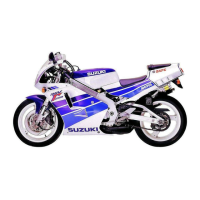2-5
PERIODIC
MAINTENANCE
AND
TUNE-UP
PROCEDURES
SPARK
PLUGS
Inspect
at
Initially
1 000 km (2 months) and
Replace Every 6 000 km (12 months)
• Remove the fuel tank. (Refer
to
page 3-2.)
The plug
gap
is
adjusted
to
0.7 - 0.8 mm (0.028 - 0.031 in).
The
gap
is
correctly adjusted using a thickness
gauge.
When
carbon
is
deposited on the spark plug, remove the carbon
with
a spark plug cleaning machine
or
by
carefully using a
tool
with
a pointed end.
If
electrodes
are
extremely worn
or
burnt,
replace the plug. Also replace the plug
if it
has
a broken in-
sulator, damaged thread, etc.
NGK BR9ES listed in the table should
be
used
as
the standard
plug. However, the heat
range
of
the plug should
be
selected
to
meet the requirements
of
speed,
actual load, fuel, etc.
If
the
plugs
need
to
be
replaced,
it
is
recommended
that
the standard
plugs listed in the table
be
selected.
Remove
the plugs and in-
spect the insulators. Proper heat
range
would
be
indicated
if
both insulators were light brown in color.
If
they
are
blacken-
ed
by carbon, they should
be
replaced by a
hot
type B R8ES
if
baked white,
by
NGK BR10ES.
Plugs
with
high heat
range
number
are
used
for
hi,gh
speed
running. These plugs
are
designed
to
be
sufficiently cooled
to
prevent overheating and
are
called cold type plugs.
Recommended spark plug
NGK
REMARKS
BRBES
If
the
standard plug
is
apt
to
get wet, replace with this plug. Hot type.
BR9ES
Standard
BR10ES If
the
standard plug
is
apt
to
overheat, replace with this plug. Cold type.
NOTE:
0.7 -
O.B
mm
"R"
type spark plug
is
installed for some specifications.
"R"
type spark plug has a resistor located
at
the
center electrode to prevent
radio
noise.
CAUTION:
Confirm the thread
size
and reach when replacing the plug.
If
the
reach
is
too
short, carbon
will
be
de-
posited on the thread
portion
of
the plug hole and engine
damage
may result.
CARBURETORS
Inspect
at
Initially
1 000 km (2 months) and
Every 6 000 km (12 months)
IDLE
RPM
ADJUSTMENT
NOTE:
Make this adjustment when the engine
is
hot.

